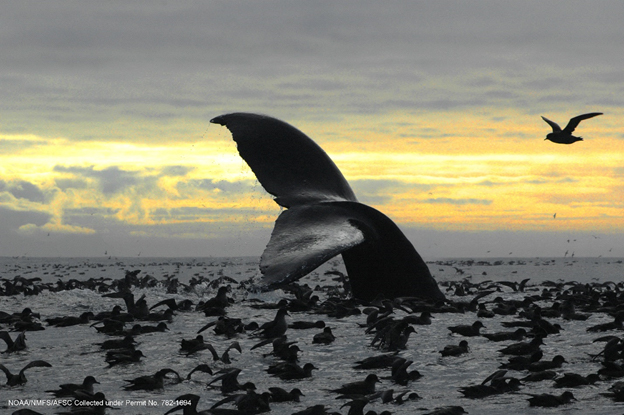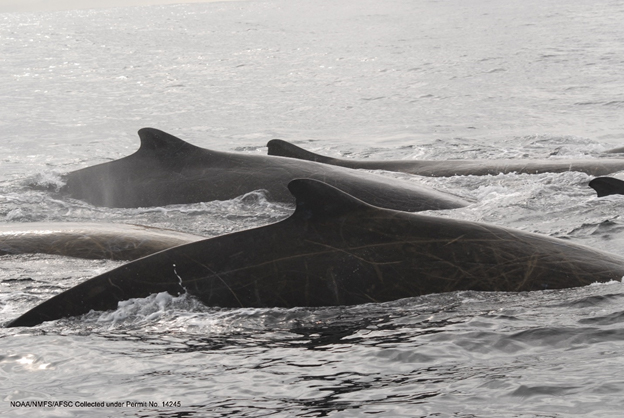
AFSC News
February 17, 2017
Where the Whales Are
First estimates of whale abundance in offshore Gulf of Alaska find some species recovering while others remain depleted 35 years after whaling
By Christine Baier
 |
Humpback whale. Photo: Brenda Rone, NOAA Fisheries |
A new study provides the most comprehensive information available on whale distribution and abundance in the offshore Gulf of Alaska since historical whaling records.
Current abundance and distribution data are essential for effective management and protection of marine mammals. Until now, what we knew about whales in the offshore Gulf of Alaska came mainly from 19th and 20th century whaling records. Due to its remote location, vast geographic area, and challenging environmental conditions, marine mammals of the offshore Gulf have been largely unsurveyed by scientists.
New research led by marine mammal scientist Brenda Rone of NOAA Fisheries? Alaska Fisheries Science Center combines data from three years of surveys to provide the most current information on whales and porpoises in the region. Surveys in 2009 and 2013 were designed to find out which marine mammals might be affected by U.S. Navy training exercises. In 2015 the team conducted the first search for the critically endangered North Pacific right whale.
"Information on some species has been collected in the nearshore Gulf of Alaska since 1980, but there was a big data gap in offshore waters," says Rone. "We were excited to have the opportunity to explore an area that had never been surveyed to this extent."
Results include:
- The first abundance estimates for sperm and blue whales in the Gulf of Alaska offshore
- Confirmation that this region is important habitat for several species including beaked, blue, and sperm whales
- No sightings of critically endangered North Pacific right whales in this region where they were historically abundant
A legacy of whaling
| |
"The Gulf of Alaska has always been celebrated for its whale-fisheries."
—Lippincott?s Magazine of Literature, Science, and Education
July 1868 |
The Gulf of Alaska once supported a flourishing whaling industry. Extensive whaling during the 19th century, followed by unchecked illegal whaling by the former USSR and Japan during the mid-20th century, devastated global populations of large whales including those in Alaskan waters.
"The Soviet Union in particular killed large numbers of whales illegally, including what was probably the bulk of a small but perhaps slowly recovering population of right whales," says Yulia Ivashchenko, a researcher at NOAA Fisheries' Alaska Fisheries Science Center who has worked to assess the true extent and impact of these catches. Ivashchenko has also recently uncovered extensive illegal catches of sperm whales by Japan, including in the Gulf of Alaska.
By 1982 the great whales had been hunted to depletion, and an international moratorium on whaling was imposed. Thirty-five years later, the consequences of uncontrolled whaling remain evident. Some species show signs of recovery, but others have virtually disappeared.
At least 14 species of whales and porpoises live seasonally or year-round in the offshore GOA. Of these, six are listed under the Endangered Species Act, including blue, fin, sei, sperm, and humpback whales. Rarest of all is the North Pacific right whale: only about 30 individuals are thought to remain in the eastern stock.
"The plight of the North Pacific right whale is an issue that is very important to us," Rone says. "I was thrilled to have an opportunity to search this historically important habitat in the hope that the rare sightings in recent years were simply a factor of effort and that we would find animals in this offshore habitat."
Rare, cryptic, and elusive
 |
Baird?s beaked whales in the Gulf of Alaska. Photo: Ernesto Vasquez, NOAA Fisheries |
Searching a half million square miles of stormy ocean is a daunting task, even if what you are looking for is as big as a whale. A wisp of breath or a sliver of back is all that a whale may show of itself between dives. Some species are especially elusive due to their lifestyle or sheer rarity.
The beaked whales, for example, are difficult to research because of their cryptic nature. They spend most of their time submerged, regularly dive to great depths and often travel singly or in small groups. Sperm whales also are often difficult to detect visually due to their long, deep dives. North Pacific right whales are hard to find simply because there are so few of them.
Scientists have learned that the best way to find rare, cryptic and elusive whales is to not only to look, but also to listen.
In all three survey years, acoustic platforms were used in concert with the visual surveys, and the combination increased the detection of elusive species like beaked and sperm whales.
The presence of the North Pacific right whale would not have been documented at all without acoustics: it was heard, but not seen. On one day in 2013 and two days in 2015, the team heard the distinctive ?upcall? and ?gunshot? calls of a right whale. The calls were faint and infrequent, and despite an intensive search, they never saw the whales.
"Until now, we didn?t know if the rarity of recent sightings was due to the absence of whales, or just that no one was out there looking for them," says Rone. "The lack of sightings in our survey underscores the precarious status of these critically endangered whales in waters where they were once abundant."
Working with whales
Although North Pacific right whales proved to be alarmingly scarce, relatively frequent sightings of beaked, blue and sperm whales during the study suggest that the Gulf of Alaska offshore is currently important habitat for these species. Prior to this research there were no abundance estimates and few contemporary sightings of either sperm or blue whales in Alaskan waters, though both species had been abundant here before their numbers plummeted under the pressure of commercial whaling.
"It?s not clear whether relatively high numbers during our study reflect a previous lack of offshore survey effort, a temporary shift in distribution, or recovery," says Rone.
Both beaked and blue whales have shown behavioral responses to sonar, so these species are susceptible to the impact of military activity in the area. Information from this study will be used to help minimize effects of operations in the U.S. Navy training area on whales in the Gulf of Alaska, so our military can protect both our coastline and our whales.
For all whale and porpoise species in the Gulf of Alaska offshore, this research helps fill a century-old gap in the information needed for their management and conservation.
More information
Rone, B. K., A. N. Zerbini, A. B. Douglas, D. W. Weller, and P. J. Clapham. 2016. Abundance and distribution of cetaceans in the Gulf of Alaska. Marine Biology 164:23. http://dx.doi.org/10.1007/s00227-016-3052-2
Ivashchenko, Y. V., and P. J. Clapham. 2015. What's the catch? Validity of whaling data for Japanese catches of sperm whales in the North Pacific. Royal Society of Open Science 2:150177. http://dx.doi.org/10.1098/rsos.150177
Ivashchenko, Y. V., R. L. Brownell, and P. J. Clapham. 2014. Distribution of Soviet catches of sperm whales Physeter macrocephalus in the North Pacific. Endangered Species Research 25:249-263. https://doi.org/10.3354/esr00641
Ivashchenko, Y. V., and P. J. Clapham. 2014. Too much is never enough: the cautionary tale of Soviet illegal whaling. Marine Fisheries Review. 76(1):1-21. https://dx.doi.org//10.7755/MFR.76.1_2.1
Rocha, R. C., Jr., P. J. Clapham, and Y. Ivashchenko. 2014. Emptying the Oceans: a Summary of Industrial Whaling Catches in the 20th Century. Marine Fisheries Review 76(4):37-48. https://dx.doi.org/10.7755/MFR.76.4
For more information please contact Marjorie Mooney-Seus
206-526-4348 (office), 774-392-4865 (cell)
|